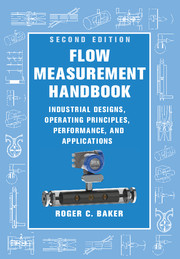Book contents
- Frontmatter
- Dedication
- Contents
- Preface
- Acknowledgements
- Nomenclature
- 1 Introduction
- 2 Fluid Mechanics Essentials
- 3 Specification, Selection and Audit
- 4 Calibration
- 5 Orifice Plate Meters
- 6 Venturi Meter and Standard Nozzles
- 7 Critical Flow Venturi Nozzle
- 8 Other Momentum-Sensing Meters
- 9 Positive Displacement Flowmeters
- 10 Turbine and Related Flowmeters
- 11 Vortex Shedding, Swirl and Fluidic Flowmeters
- 12 Electromagnetic Flowmeters
- 13 Magnetic Resonance Flowmeters
- 14 Ultrasonic Flowmeters
- 15 Acoustic and Sonar Flowmeters
- 16 Mass Flow Measurement Using Multiple Sensors for Single-Phase Flows
- 17 Multiphase Flowmeters 508
- 18 Thermal Flowmeters
- 19 Angular Momentum Devices
- 20 Coriolis Flowmeters
- 21 Probes for Local Velocity Measurement in Liquids and Gases
- 22 Verification and In Situ Methods for Checking Calibration
- 23 Remote Data Access Systems
- 24 Final Considerations
- References
- Main Index
- Flowmeter Index
- Flowmeter Application Index
14 - Ultrasonic Flowmeters
Published online by Cambridge University Press: 05 August 2016
- Frontmatter
- Dedication
- Contents
- Preface
- Acknowledgements
- Nomenclature
- 1 Introduction
- 2 Fluid Mechanics Essentials
- 3 Specification, Selection and Audit
- 4 Calibration
- 5 Orifice Plate Meters
- 6 Venturi Meter and Standard Nozzles
- 7 Critical Flow Venturi Nozzle
- 8 Other Momentum-Sensing Meters
- 9 Positive Displacement Flowmeters
- 10 Turbine and Related Flowmeters
- 11 Vortex Shedding, Swirl and Fluidic Flowmeters
- 12 Electromagnetic Flowmeters
- 13 Magnetic Resonance Flowmeters
- 14 Ultrasonic Flowmeters
- 15 Acoustic and Sonar Flowmeters
- 16 Mass Flow Measurement Using Multiple Sensors for Single-Phase Flows
- 17 Multiphase Flowmeters 508
- 18 Thermal Flowmeters
- 19 Angular Momentum Devices
- 20 Coriolis Flowmeters
- 21 Probes for Local Velocity Measurement in Liquids and Gases
- 22 Verification and In Situ Methods for Checking Calibration
- 23 Remote Data Access Systems
- 24 Final Considerations
- References
- Main Index
- Flowmeter Index
- Flowmeter Application Index
Summary
Introduction
The first proposal for the use of ultrasound for flow measurement, according to Thompson (1978), seems to have been in a German patent of 1928. It was not until after 1945 that the idea became more widely proposed, when the development of piezoelectric transducers made ultrasonic applications really attractive. Fischbacker (1959) provided an early review of ultrasonic flowmeters. Sanderson and Hemp's (1981) review provided a further source of information.
The main types of meter are:
Transit-time, also known as a time-of-flight flowmeter, the most accurate of the family, is available as a spool piece or clamp-on meter for liquids and gases. Ultrasonic meters can also be retrofitted into a pipe. Measurement uncertainty will be from a fraction of a percent for spool piece meters to of order 5% for clamp-on. A transducer in direct contact with the fluid is said to be “wetted”, as compared with one which is fixed to the outside of the pipe, or has a protective layer between it and the fluid. Transducers for gases are usually expected to be in contact with the gas i.e. wetted, a rather inappropriate word for this context! Clearly, for the clamp-on versions this is not the case.
The Doppler meter is suitable for predominantly liquid flows. It has an important niche in some applications where there is an adequate second component in the fluid to provide reflection of the beam, but the meter is unlikely to operate satisfactorily if the flow does not have a continuous liquid component. It is sensitive to installation. Measurement uncertainty is unlikely to be better than about ±2% of full scale and at worst it may be indeterminate. With gating of the returning pulse a more powerful instrument should be achieved. It was initially oversold to such an extent that many people assumed that, when an ultrasonic flowmeter was mentioned, it was a Doppler meter.
The cross-correlation flowmeter should be capable of reasonable precision (between the previous two devices), requires a disturbed liquid or multiphase flow to operate satisfactorily, and has mainly been of interest for measurement in multiphase flows. However, recently there has been a new clamp-on design which is claimed to be for gases.
- Type
- Chapter
- Information
- Flow Measurement HandbookIndustrial Designs, Operating Principles, Performance, and Applications, pp. 419 - 483Publisher: Cambridge University PressPrint publication year: 2016
- 1
- Cited by



